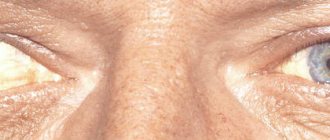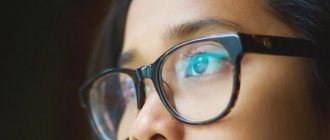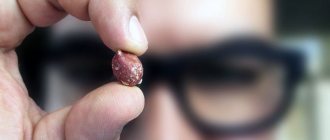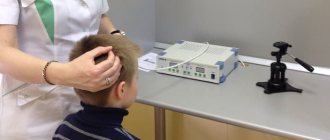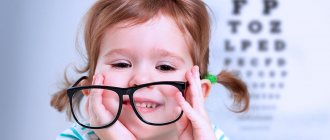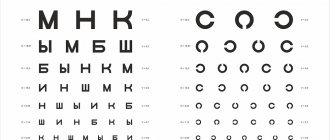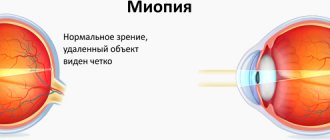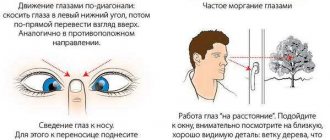What is myopia?
Myopia is an eye disease in which a person has difficulty seeing objects located in the distance, but clearly sees objects that are close. Nearsightedness is also called myopia.
According to data provided by the World Health Organization, many people suffer from this problem - up to 30% of the world's population. Moreover, the peak of its development occurs in children at puberty.
Our eyes contain a cornea and a lens. These components of the eye are capable of transmitting rays by refracting them. And an image appears on the retina. This image then becomes nerve impulses and is transmitted along the optic nerve to the brain.
If the cornea and lens refract the rays so that the focus is on the retina, then the image will be clear. Therefore, people without any eye diseases will see well.
With myopia, the image appears blurry and unclear. This may happen for the following reasons:
– if the eye lengthens greatly, the retina moves away from the stable focus location. In people with myopia, the eye reaches thirty millimeters. And in a normal healthy person, the size of the eye is twenty-three to twenty-four millimeters; – if the lens and cornea refract light rays too much.
According to statistics, every third person on earth suffers from myopia, that is, myopia. It is difficult for such people to see objects that are far from them. But at the same time, if a book or notebook is located close to the eyes of a person who is myopic, then he will see these objects well.
Content:
Myopia is...
The myopic condition was first described back in the 4th century in the treatises of the famous philosopher Aristotle, who noticed that in order to better see distant images, some people have to squint their eyes.
The philosopher gave the name to this phenomenon – myops (squinting). In modern medicine, nearsighted vision is called myopia.
To understand what we are talking about, let us recall what ocular refraction is, due to violations of which such eye “anomalies” develop.
Human visual perception is determined by the special structural structure of the eye, which, passing rays of light through itself, collects them into focus in the central part of the inner shell of the eye - on the retina, which performs the functions of a visual analyzer.
Here, processes of transformation of light rays take place and transmit them to the optic nerves of the brain in the form of impulses, followed by the synthesis of full-fledged volumetric images.
The main parameters that influence the optical-refractive system are optical (refractive) power and the length of the internal visual ocular axis, which are responsible for the focusing zones of light beams.
A healthy eye focuses light in the central region of the retina, which is medically called emmetropia.
Correct refraction ensures good vision of objects at any distance - close and far, increasing or decreasing the optical power of the natural eye lens - the lens. In ophthalmology, this process is called accommodation.
Disturbances in the functions of the refractive system lead to a shift in focus and, according to its location, the development of myopia or farsightedness.
Is myopia a minus or a plus?
Often, when hearing the diagnosis of myopia for the first time, patients have a logical question: “Which glasses are required to correct vision - minus or plus.” In order to better see objects located in the distance, you must wear glasses marked minus. In this way, it will be possible to correct the distance between the retina and the focus.
The lenses used in glasses to correct myopia are called diverging or negative lenses. They have a concave shape. Only an ophthalmologist can determine the number of minuses, or in other words, the strength in diopters. This depends, first of all, on the state of vision and the degree of myopia - low, moderate or severe.
Symptoms of myopia
Symptoms of myopia include rapid eye fatigue when driving a car or while playing sports. If these are the symptoms that bother you when you wear glasses or contact lenses, you will need to be examined by a doctor and possibly change your glasses or contacts.
Myopia develops already in childhood. Children at school begin to have difficulty seeing distant objects and squint.
In order to improve vision, nearsighted people should wear lenses or glasses with minus value. There is often a need to change lenses as vision deteriorates. But it should be remembered that glasses will not change the development of myopia, they only change the refraction of light.
Causes of myopia
There are several reasons why a person begins to see objects located in the distance worse:
- Genetic predisposition to the development of myopia. It is important to consider whether one or both parents suffer from myopia. If both father and mother are susceptible to pathology, then in 50% of cases, it will also occur in the child before he or she comes of age. If the parents are healthy, then the risk of developing the disease is significantly reduced and is 8%.
- Lack of nutrients, vitamins, and minerals in the body. First of all, vision is affected by B vitamins and vitamin C, as well as microelements such as magnesium, zinc, copper, manganese. All of them are necessary for the proper development and formation of the tissues of the sclera of the eye.
- Any eye strain caused by prolonged and continuous visual work. This also includes reasons such as: incorrectly selected or positioned lighting, lack of breaks while working at the computer, failure to maintain the minimum distance to books, notebooks, telephones, televisions, etc.
- Lack of correction when the first symptoms of myopia appear. If you ignore the signs of the disease, myopia will progress and lead to significant deterioration of vision.
- Incorrectly selected glasses or contact lenses for vision correction in case of early myopia.
- A congenital cause, such as weakness of the eye muscles responsible for changing the curvature of the lens.
- Some vision diseases, for example, strabismus, astigmatism and others.
- Increased intracranial and intraocular pressure.
- Other reasons include multiple infectious diseases, disruptions in the hormonal system, birth and traumatic brain injuries. All those conditions that cause weakening of the body and disrupt the flow of nutrients to the eye.
What is the reason for the development of myopia
In the vast majority of cases, myopia is a genetically inherited disease. If parents have a refractive error, the risk of developing an ocular anomaly in children is 50%.
In the absence of family heredity, the disease manifests itself only in 8% of cases.
Many factors contribute to the development of myopia:
- lack of eye hygiene;
- frequent and prolonged work with texts at close range, causing visual strain;
- inappropriate workplace lighting;
- prolonged viewing of television programs;
- reading in moving vehicles;
- incorrect body position when writing and reading.
Myopia is often accompanied by other ophthalmological pathologies - astigmatism, amblyopia, strabismus, keratoglobus or keratoconus.
Unfavorable factors for vision are previous infectious processes, hormonal instability, trauma during childbirth and intoxication.
The progression of a refractive defect is facilitated by illiterate correction for already identified pathology, and a lack of necessary microelements in the body (Cr, Mn, Cu, Zn).
Degrees of myopia
There are several degrees of myopia, which is determined by the distance the focus is removed from the retina:
- 1st degree. The first, or low degree, of myopia refers to a distance not exceeding 3 diopters. As for the eye, its length increases by an average of 1.5 mm from the accepted norm. A person does not experience problems when looking at objects at a close distance, but when looking into the distance, objects are slightly blurry.
- 2nd degree. The second degree of myopia refers to the distance between the focus and the retina, in the range from 3 to 6 diopters. The length of the eye increases by an average of 3 mm. With moderate myopia, the vessels inside the eyeball are stretched and have less thickness. Often this condition provokes the onset of degenerative processes in the retina. Nearby, a person can see objects clearly, but at a distance not exceeding 30 cm. When moving away, their contours become unclear, and the picture itself is blurred.
- 3rd degree. In the third degree of myopia, the distance between the focus and the retina exceeds 6 diopters. This is the highest degree of myopia. In this case, the eye undergoes significant changes, the retina and blood vessels become thinner, to such an extent that the sclera becomes visible. Vision is reduced so that a person can only see fingers located at arm's length.
The higher the degree of myopia, the more the eye is elongated and the more its blood vessels are stretched. This leads to the development of serious complications and complete blindness.
Possible complications
The progression of myopia, caused by age-related changes and increased loads during this period, most often stops upon reaching 20 years (for women) and 22 years (for men). The visual defect itself is not dangerous, but with the development of high degrees of myopia, the risk of developing severe complications increases:
- Retinal disinsertion. An increase in the size of the eyeball entails its stretching and the threat of detachment and rupture, which can lead to loss of vision partially or completely;
- Glaucoma. With dystrophic changes in the ocular structures (most often age-related), an increase in IOP is possible, which in most cases leads to damage to the optic nerve and a decrease in visual acuity;
- Retinal dystrophy. It is the result of degenerative processes in the tissues of the eye, changes in the functioning of the circulatory system and disturbances in the nutrition of nerve fibers;
- Cataract. Violation of the passage of light rays through the lens is most often of an age-related nature, but eye strain when trying to look at distant objects plays an important role in disrupting metabolic processes.
The threat of complications can arise at any age, even after surgical correction. Therefore, people even with a mild degree of myopia are recommended to undergo preventive examinations by an ophthalmologist.
Complicated myopia
Myopia, as a rule, does not greatly affect a person’s activities and capabilities, since this vision defect can be easily corrected with the help of lenses and glasses. But it also happens that myopia is very pronounced and requires serious interventions.
If you have to constantly change your glasses to stronger ones, this means that myopia is progressing. This means that the eyeball is enlarged. In turn, this leads to decreased visual acuity. Since there may be defects in the retina, its detachment is also possible. Enlargement of the eyeball can occur constantly throughout life, and therefore vision will also deteriorate.
With such a complex form of myopia, serious consequences are possible, including complete loss of vision.
"False" myopia
In ophthalmology there is such a thing as pseudomyopia or “false” myopia. This condition, unlike true myopia, is completely curable. However, it is important to seek help from a doctor when the first symptoms appear.
Most often, school-age children suffer from pseudomyopia. It occurs due to the fact that the load on vision, namely on the accommodative muscle, increases significantly. If its spasm occurs, a person loses the ability to clearly see objects located in the distance. You may also experience pain in the eye sockets, head, and temporal region. The eyes get tired quickly.
The development of false myopia can be preceded by infectious diseases, rheumatism, tuberculosis, vegetative-vascular dystonia, hysteria and other causes.
If false myopia was noticed during the first year, then you can quickly get rid of it. In the case when a person delays contacting a doctor, the disease can develop into true myopia.
Treatment depends on the causes of this condition. It is imperative to normalize your diet and daily routine. Particular attention should be paid to the workplace and proper lighting. It is necessary to reduce the load on vision and the body as a whole as much as possible. If there is a doctor’s recommendation, then you should use glasses or lenses to correct vision, take medications to improve eye nutrition, and perform specialized sets of exercises.
Methods for improving vision for myopia
In order to improve vision, if you have been diagnosed with myopia, you must strictly follow all the doctor’s instructions. Treatment of myopia is a complex process that can only be dealt with with the help of an ophthalmologist.
Modern methods of improving vision are varied and patients have plenty to choose from:
- Correction of myopia using laser.
- Optical correction of myopia.
- Methods of surgical intervention. Used when the disease is highly developed. It is possible to replace the lens with an intraocular lens and install an actual lens.
- Drug treatment of the disease.
- Correction of nutrition to improve blood supply to the eye and the supply of nutrients to it.
Laser vision correction for myopia
Laser correction is a modern, safe and effective way to get rid of the problem. This treatment will allow you to stop wearing glasses and contact lenses. The essence of the intervention comes down to the fact that the shape of the cornea is changed for a person, making it flatter, due to which its optical power is reduced. That is, with the help of a laser it is possible to create the effect of wearing glasses, as if located inside the eyes. As a result, light rays, after refraction in the lens of the eye, are focused on its retina.
There are laser correction methods such as LASIK (creating corneal parameters using a template), Super LASIK (creating individual corneal parameters) and PRK (used for thin corneas and low myopia). Each method has its own distinctive features and is used depending on the financial capabilities of the person and the condition of his eyes.
Glasses for myopia
Glasses are most often used to correct the vision of a person suffering from myopia. By installing diverging lenses in them, they weaken the optical system of the eye, and the image is pushed back onto the retina. Sometimes it is necessary to wear glasses with cylinders if myopia is complicated by astigmatism.
It is better to use glasses with double lenses. They are divided into two parts and allow you to see objects equally well, both at long and near distances.
On the subject: 5 methods to relieve eye fatigue
Myopia: causes, symptoms, treatment and prevention
Myopia is the most common ophthalmological problem, which in most cases is inherited, but can also develop independently. With myopia, a person has difficulty seeing objects at a long distance. They seem fuzzy and blurry to him. This happens because the focus of the image does not fall on the retina, but is located in front of it, because the refraction of the light flux occurs stronger than necessary.
Depending on the degree of myopia, a person may see objects with slight blurriness or not be able to distinguish the outlines of objects at all due to severe blurring of the image. If myopia is combined with astigmatism, then optical defects are added to poor visibility. In this case, a person sees straight lines as curved, and the image of objects is doubled and distorted. Treatment of myopia is complex and lengthy; it requires regular compliance with all the instructions of specialists.
Prevention of myopia
Any disease, including myopia, is easier to prevent than to cure. Therefore, it is important to prevent myopia from an early age.
To do this, you must follow the following recommendations:
- Maintain a distance of at least 30 cm between the eyes and the monitor, book, tablet, etc. This will reduce the effort required to focus vision and prevent the development of both temporary and permanent myopia.
- The eyes need to be given rest. The longer your vision is strained, the higher the risk of developing myopia. Therefore, you definitely need to take a break after 40 minutes of visual work.
- You should not read while lying on your back or side, or in a moving object (in a car, train, subway, etc.). The accommodation apparatus will have to reconfigure itself every second in order to capture the image, which will inevitably lead to its overstrain. If you read while lying down, then one eye will always be further away from the object than the other, which also causes visual strain.
- It is important to always keep your back straight. Correct posture will allow you to look at the object of vision from the required angle.
- Due attention must be paid to adequate lighting. This will relieve your eyes from overstrain. Sunlight is optimal for the human eye. But since it is not always possible to achieve such lighting when working, it is important to use artificial light. Be sure to install a desk lamp when working in the evening hours.
- It is important to protect your eyesight from the damaging effects of ultraviolet radiation.
- Proper nutrition is an equally important factor for the prevention of myopia. Daily intake of minerals and vitamins will allow the organ of vision to function better and avoid overwork.
Vitamins for eyes for myopia
In order to avoid the development of myopia, it is important to consume vitamins that help preserve vision. If this is not possible, then you should use special complexes that your doctor can recommend.
The most relevant eye vitamins for myopia:
- Thiamine or vitamin B1. It affects the functioning of the nervous system as a whole, and its deficiency will lead to the eyes quickly getting tired and binocular vision to deteriorate, which increases the risk of developing myopia.
- Riboflavin or vitamin B2. Its lack negatively affects the elasticity of blood vessels and provokes their ruptures, including those located in the eyeballs. Increased fatigue and tension of the accommodative muscle are manifestations of insufficient intake of riboflavin in the body.
- Niacin or vitamin B3. With its lack, the blood supply to the optic nerve deteriorates.
- Priridoxin or vitamin B6. Its deficiency causes inflammation of the optic nerve and provokes conjunctivitis.
- Cyanocobolamine or vitamin B12. Without it, your eyes water and get tired faster.
For the prevention and treatment of myopia, it is important to supply all vitamins, and especially those belonging to group B.
On the subject: Vitamins for the eyes - which are the best?
Why myopia develops in children: causes of the disease
What are the causes of congenital myopia? Childhood myopia is often associated with pathology of the visual apparatus, which is inherited from one or two parents.
Refractive power depends on the shape of the eyeball, the curvature and thickness of the cornea, and the curvature of the anterior and posterior surfaces of the lens. If there is at least one developmental disorder in the listed components of the optical system of the eye, we can talk about a high risk of developing myopia. Also, the appearance of myopia in childhood can be affected by:
- injuries and previous infections;
- various systemic diseases;
- visual stress and a poorly balanced diet;
- unfavorable environmental conditions in the region of residence;
- lack of physical activity;
- primary weakness of accommodation.
